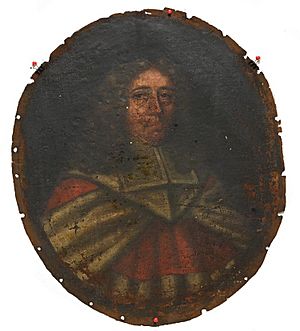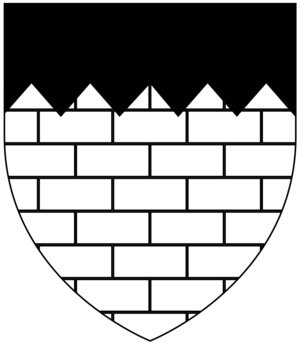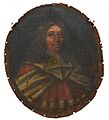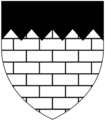Sir Richard Reynell, 1st Baronet facts for kids
Sir Richard Reynell, 1st Baronet (1626 – 18 October 1699), was an important judge from England who had a very successful career in Ireland. He became the Lord Chief Justice of the King's Bench in Ireland, which was a very high legal position. He was also the first person to hold the title of Baronet in his family, the Reynells of Laleham.
Contents
Early Life and Becoming a Lawyer
Richard Reynell was born in Devon, England, in 1626. His family, the Reynells, were a very old and respected family from the West Country. His father was also named Sir Richard Reynell. Richard had an older brother, Sir Thomas Reynell, who became a politician.
In 1642, Richard started studying law at a famous place called Middle Temple in London. He finished his studies and became a lawyer in 1653. He then decided to move to Ireland to work. In 1658, he joined the King's Inn, which is a special society for lawyers in Ireland.
He became a very busy lawyer and was known for helping all kinds of people, even those who were Roman Catholic. At that time, being Catholic was sometimes difficult, and helping them could cause problems. He bought a house in Dublin and married a woman from a Dublin family.
A Career in Politics and Law
In 1661, Richard Reynell was chosen to be a member of the Irish House of Commons. This was like being a representative in the government. He represented a place called Athboy.
He also worked as a traveling judge, called a judge of assize, in 1670. This meant he traveled around the country to hear court cases. In 1673, he was given the important legal title of Second Sergeant and was also made a knight. This meant he was now called "Sir Richard Reynell."
He was good friends with Arthur Capel, 1st Earl of Essex, who was the Lord Lieutenant of Ireland. The Lord Lieutenant was the King's main representative in Ireland.
Becoming a Judge
In 1674, because of his friend Lord Essex's recommendation, Sir Richard became a judge in the Court of King's Bench (Ireland). Lord Essex thought he was one of the best judges in Ireland.
When a new Lord Lieutenant, James Butler, 1st Duke of Ormonde, arrived in 1677, Lord Essex told him that Reynell was one of the few Irish judges who was smart and healthy enough to do his job well. Ormonde agreed.
However, there was a lot of fear and suspicion about Catholics at the time, known as the Popish Plot. Because Sir Richard was known for being fair to Catholic clients, some people didn't trust him. Even though he came from a good family, he didn't have much power in the King's court in England.
In 1678, Sir Richard was made a baronet. This was a special honor, and it wasn't common for Irish judges to receive it. In 1682, he also became a member of the Privy Council of Ireland, which was a group of important advisors to the King.
Dismissal and Return to England
When King James II became King in 1685, he didn't want Sir Richard to be a judge anymore. Sir Richard was removed from his job in 1686. Some people thought it was because he was rich and independent, and the new King's representative in Ireland, Tyrconnell, didn't like that.
Sir Richard's wife had passed away a few years earlier, so he didn't have much reason to stay in Ireland. He went back to England and stayed there until after the Glorious Revolution in 1688. This was a big change in England where King James II was replaced by King William III and Queen Mary.
In 1690, Sir Richard was chosen to be a member of the English Parliament for his family's area, Ashburton. His older brother had stepped down so Richard could take his place. Sir Richard worked on several committees, especially those dealing with Irish matters. The new government saw him as a loyal supporter.
Lord Chief Justice of Ireland
In 1691, after showing his loyalty to the new King, Sir Richard finally received a big promotion. He became the Lord Chief Justice of Ireland. However, his time in this role was a bit difficult because he had made some enemies.
He was seen as a Tory (a political group) when the Whigs were more powerful. In 1693, some people even falsely accused him of supporting the old King James II.
In 1692, a secret letter sent to the King claimed that Sir Richard and other judges were unfair and favored Irish interests over English ones. The King didn't believe these serious accusations. However, Sir Richard's enemies in England blamed him for problems in Ireland, like the Irish Parliament not agreeing to the Treaty of Limerick. This treaty was supposed to help bring peace to Ireland.
There were also old rumors that Sir Richard was too understanding towards Catholics. A man named Colonel FitzGerald even made a wild accusation that Sir Richard was part of a secret plan to kill King William III.
In December 1693, Sir Richard spoke in the English Parliament to defend himself. He spoke very well. His powerful friends, like Sir Edward Seymour, 4th Baronet, defended him strongly. They pointed out how silly it was to think Sir Richard would try to kill the King who had given him so much. Seymour said Sir Richard was "an honest and prudent man." Sir Richard was completely cleared of the charges. It is said that these attacks hurt him so much that he never went to Parliament again, but he did continue to attend meetings of the Privy Council of England.
People also complained that Sir Richard received money for traveling to hold court sessions, but he didn't always go. Sir Richard explained that it was hard to be Lord Chief Justice of Ireland and also have duties in England.
Later Years and Death
More serious than the false accusations of treason were concerns about his health. He found the work of traveling for court sessions too much. In 1695, a leader in Ireland said that Sir Richard was very ill and "not likely to live a month longer." He actually lived for four more years and was still able to attend some meetings. However, he was dismissed from his judge position that same year because of his declining health. He was still paid half his salary for six months.
Sir Richard Reynell died in London in 1699. He had a very impressive funeral procession through London, and his body was taken back to Devonshire to be buried at East Ogwell.
Family Life
In 1660, Sir Richard married Hester Beckett in Dublin. They had two sons, Richard and Henry, and four daughters, including Elizabeth and Hester. His older son, Richard, became the second baronet after his father. His younger son, Henry, also became a lawyer in Dublin. His daughter Elizabeth married William Richardson in 1695, but they did not have children.
In 1682, while Sir Richard and Lady Hester Reynell were traveling in France, Hester passed away in Abbeville. Sir Richard brought her body back to Devonshire for burial.
Sir Richard's home in Dublin was on Church Street, near the building known today as the Four Courts. He also owned a house next to the King's Inns.
His Legacy
Sir Richard Reynell's success as a lawyer and judge was partly due to his upper-class background. He could easily talk with important people like Lord Essex and Lord Ormonde as equals. Everyone, even his critics, agreed that he was a very skilled lawyer. Although his mental abilities might have declined in his later years, he is remembered as one of the most important Irish judges of his time.
Images for kids





